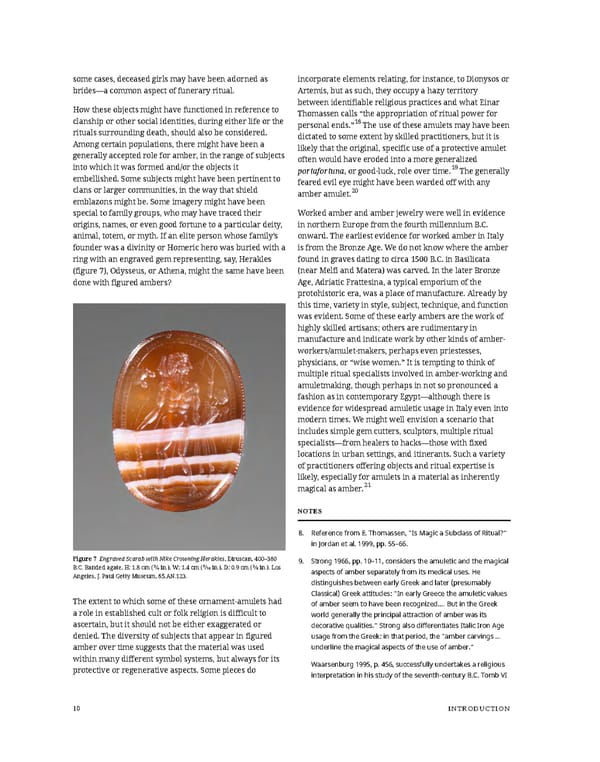some cases, deceased girls may have been adorned as incorporate elements relating, for instance, to Dionysos or brides—a common aspect of funerary ritual. Artemis, but as such, they occupy a hazy territory between identifiable religious practices and what Einar How these objects might have functioned in reference to Thomassen calls “the appropriation of ritual power for clanship or other social identities, during either life or the personal ends.”18 The use of these amulets may have been rituals surrounding death, should also be considered. dictated to some extent by skilled practitioners, but it is Among certain populations, there might have been a likely that the original, specific use of a protective amulet generally accepted role for amber, in the range of subjects often would have eroded into a more generalized into which it was formed and/or the objects it portafortuna, or good-luck, role over time.19 The generally embellished. Some subjects might have been pertinent to feared evil eye might have been warded off with any clans or larger communities, in the way that shield amber amulet.20 emblazons might be. Some imagery might have been special to family groups, who may have traced their Worked amber and amber jewelry were well in evidence origins, names, or even good fortune to a particular deity, in northern Europe from the fourth millennium B.C. animal, totem, or myth. If an elite person whose family’s onward. The earliest evidence for worked amber in Italy founder was a divinity or Homeric hero was buried with a is from the Bronze Age. We do not know where the amber ring with an engraved gem representing, say, Herakles found in graves dating to circa 1500 B.C. in Basilicata (figure 7), Odysseus, or Athena, might the same have been (near Melfi and Matera) was carved. In the later Bronze done with figured ambers? Age, Adriatic Frattesina, a typical emporium of the protohistoric era, was a place of manufacture. Already by this time, variety in style, subject, technique, and function was evident. Some of these early ambers are the work of highly skilled artisans; others are rudimentary in manufacture and indicate work by other kinds of amber- workers/amulet-makers, perhaps even priestesses, physicians, or “wise women.” It is tempting to think of multiple ritual specialists involved in amber-working and amuletmaking, though perhaps in not so pronounced a fashion as in contemporary Egypt—although there is evidence for widespread amuletic usage in Italy even into modern times. We might well envision a scenario that includes simple gem cutters, sculptors, multiple ritual specialists—from healers to hacks—those with fixed locations in urban settings, and itinerants. Such a variety of practitioners offering objects and ritual expertise is likely, especially for amulets in a material as inherently magical as amber.21 NOTES 8. Reference from E. Thomassen, “Is Magic a Subclass of Ritual?” in Jordan et al. 1999, pp. 55–66. Figure 7 Engraved Scarab with Nike Crowning Herakles, Etruscan, 400–380 9. Strong 1966, pp. 10–11, considers the amuletic and the magical B.C. Banded agate, H: 1.8 cm (3⁄4 in.), W: 1.4 cm (9⁄16 in.), D: 0.9 cm (3⁄8 in.). Los Angeles, J. Paul Getty Museum, 85.AN.123. aspects of amber separately from its medical uses. He distinguishes between early Greek and later (presumably Classical) Greek attitudes: “In early Greece the amuletic values The extent to which some of these ornament-amulets had of amber seem to have been recognized.… But in the Greek a role in established cult or folk religion is difficult to world generally the principal attraction of amber was its ascertain, but it should not be either exaggerated or decorative qualities.” Strong also differentiates Italic Iron Age denied. The diversity of subjects that appear in figured usage from the Greek: in that period, the “amber carvings … amber over time suggests that the material was used underline the magical aspects of the use of amber.” within many different symbol systems, but always for its Waarsenburg 1995, p. 456, successfully undertakes a religious protective or regenerative aspects. Some pieces do interpretation in his study of the seventh-century B.C. Tomb VI 10 INTRODUCTION
 Ancient Carved Ambers in the J. Paul Getty Museum Page 19 Page 21
Ancient Carved Ambers in the J. Paul Getty Museum Page 19 Page 21